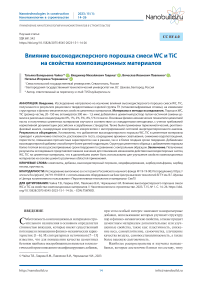Влияние высокодисперсного порошка смеси Wc и TiC на свойства композиционных материалов
Автор: Чайка Татьяна Валерьевна, Гавриш Владимир Михайлович, Павленко Вячеслав Иванович, Черкащина Наталья Игоревна
Журнал: Нанотехнологии в строительстве: научный интернет-журнал @nanobuild
Рубрика: Применение нанотехнологий и наноматериалов в строительстве
Статья в выпуске: 1 т.15, 2023 года.
Бесплатный доступ
Введение. Исследование направлено на изучение влияния высокодисперсного порошка смеси WC, TiC, полученного в результате рециклинга твердосплавных изделий группы ТК (титановольфрамовые сплавы), на изменение структурных и физико-механических свойств цементных материалов. Материалы и методы исследования. Порошок WC, TiC (размер частиц 20-150 нм, агломератов 300 нм - 1,5 мкм) добавляли в цементный раствор путем частичной замены цемента в различных концентрациях 0%, 1%, 2%, 3%, 4%, 5 % по массе. Основные физико-механические показатели цементной пасты и полученных цементных материалов изучали в соответствии со стандартными методиками, с учетом требований нормативной документации российских и зарубежных стандартов. Также были применены термокинетический, рентгенофазовый анализ, сканирующая электронная микроскопия с интегрированной системой энергодисперсионного анализа. Результаты и обсуждение. Установлено, что добавление высокодисперсного порошка WC, TiC в цементные материалы приводит к увеличению плотности, растекаемости теста, сокращению времени схватывания, снижению водопоглощения, пористости, повышению прочностных характеристик как в ранние, так и в более поздние сроки твердения. Добавление высокодисперсной добавки способствует более ранней гидратации. Структура цементного образца с добавлением порошка более плотная во все рассматриваемые сроки твердения по сравнению с контрольным образцом. Заключение. Полученные результаты исследования представляют важное значение для понимания механизмов действия высокодисперсных частиц WC, TiC на цементные материалы, что в дальнейшем может быть использовано для улучшения свойств композиционных материалов на основе цемента различных областей применений.
Композиты, добавка, высокодисперсный порошок, модифицирование, карбид вольфрама, карбид титана, прочность
Короткий адрес: https://sciup.org/142237350
IDR: 142237350 | УДК: 691.542 | DOI: 10.15828/2075-8545-2023-15-1-14-26
Текст научной статьи Влияние высокодисперсного порошка смеси Wc и TiC на свойства композиционных материалов
Себестоимость композиционных материалов строительного назначения в основном определяется стоимостью вяжущих, которые имеют существенный потенциал в повышении физико-механических характеристик [1–6]. Из литературных источников [7–13] известно, что для повышения качества цементных бетонов наиболее востребованным является технологический прием введения модифицирующих добавок, при этом особый интерес занимают наноразмерные добавки, использование которых улучшает структуру пор и физико-механические свойства, а также придает цементным материалам дополнительные или улучшенные свойства, такие как: пластичность, снижение веса, самоуплотнение, самоочистка, улучшение качества воздуха, самовосстанавливаемость, а также более высокую долговечность.
Наиболее распространены и изучены нанодобавки, которые достаточно близки по составу, типу
ПРИМЕНЕНИЕ НАНОТЕХНОЛОГИЙ И НАНОМАТЕРИАЛОВ В СТРОИТЕЛЬСТВЕ химических связей и физико-химическим характеристикам к исходным вяжущим веществам и продуктам их гидратации, такие как наночастицы SiO2 в различных формах (пирогенные нанопорошки; нанопорошки, осажденные из раствора Na2SiO3; коллоидный золь SiO2; нано-SiO2 в сочетании с другими компонентами и др.) [14–16], нанопорошок оксид алюминия Al2O3[17–20], нанопорошок CaCO3 [21], оксид титана TiO2 [22–24] и др. В качестве нанораз-мерных инертных, химически не активных по отношению к цементным системам добавок в цементных композитах нашли применение углеродные наночастицы (фуллерены, нанотрубки, астралены и др.) [25–28]. Многие исследователи [29–36] считают, что добавление комбинации наночастиц более эффективно для улучшения механических свойств бетона, чем индивидуальное использование добавок.
В исследовании [37] рассматривается роль наночастиц SiO2, CaCO3 и Ca(OH)2, которые заменяются в цементе в различных бинарных и тройных комбинациях путем изменения дозировки 2% и 5% по весу. Результаты экспериментов показали, что механические свойства бетонных смесей были улучшены на 10–45% благодаря добавлению наноматериалов в их оптимальной дозировке, которая в тройной комбинации составляет 2% и 5% для повышения коррозионной стойкости. Однако более высокие результаты по долговечности (от 5% до 60%) были достигнуты в бинарной комбинации с 2% заменой.
По мнению авторов [38], комбинация 0,5% на-норазмерного глинозема Al2O3 и 1% наноразмерного диоксида титана TiO2 от массы цемента приводит к компактной и плотной микроструктуре с меньшим количеством пор, что приводит к высокой оптимизации механических свойств. По сравнению с контрольным образцом прочность на сжатие, разрыв при растяжении и изгиб увеличилась на 42%, 34% и 28% соответственно. Наночастицы обеспечивают нуклеационные участки для образования дополнительного геля C-S-H и контролируют рост Ca(OH)2 в цементной системе.
В настоящее время много работ уделяется исследованию влияния комбинации наночастиц как с промышленными отходами [39–46], так и с отходами сельского хозяйства [47–49] на физико-механические свойства цементных материалов.
Сочетание 10% отходов текстильного шлама с 3% наноструктурированным оксидом алюминия обеспечивает улучшенные характеристики прочности и долговечности цементного бетона. Добавление наночастиц оксида алюминия имеет двойной эффект, улучшает свойства гидратации, а также действует как наполнитель [41].
В исследовании [44] разработаны новые типы бетонных смесей с улучшенной зоной сцепления и прочностными характеристиками, содержащие 30% резиновой крошки (из отходов резиновых шин) в качестве заменителя, обычный портландцемент был заменен 20% измельченным доменным шлаком и различным содержанием наночастиц из отходов стеклянных бутылок (3, 6, 9 и 12%). Анализ микроструктуры бетонных смесей показал образование плотных гелей и меньшего количества пор с приемлемыми техническими свойствами.
Авторами обнаружено [47], что сочетание наночастиц Al2O3 с содержанием 3% и 10% золы рисовой шелухи для создания модифицированных цементных бетонов с повышенными характеристиками прочности и долговечности оказалось эффективным и продуктивным для экологически чистого бетонного материала. При использовании золы отходов сахарного тростника в качестве замены цемента и нанокремнезема в диапазоне от 1 до 6% по массе цемента достигнуто увеличение прочности на сжатие на 80% и прочности на изгиб на 90% по сравнению с контрольным образцом [49].
Из-за сложного процесса получения, высокой стоимости производства наноматериалов и отсутствия технологии крупномасштабного производства применение нанопорошков в качестве добавок в цементные материалы значительно увеличивает стоимость строительства, поэтому они не нашли широкого применения в практической строительной инженерии. Исключение составляют технологии, в которых нанодисперсные материалы образуются в качестве побочного продукта или из отходов производства различных предприятий, не требующих высоких затрат при их использовании, с применением современной тенденции ресурсо- и энергосбережения. Одной из таких технологий является производство нанопорошков из вольфрамсодержащего лома твердых сплавов типа ВК, ТТК, ТК, ВНЖ и др. [50]. Однако, ввиду отсутствия достаточных исследований о возможности и целесообразности применения на-норазмерных вольфрамсодержащих порошков в качестве добавок в цементные композиты, определение эффективности и целесообразности их применения является весьма актуальным и требует комплексного изучения, что позволит расширить номенклатуру модифицирующих добавок для цементных материалов.
В данной работе представлены результаты влияния введения высокодисперсного порошка, состоящего из смеси карбидов вольфрама и титана, полученных из твердосплавного лома производства, на изменение структурных и физико-механических свойств цементных материалов. Выбор данных добавок обусловлен вариативностью свойств, как показали предыдущие исследования [51–52], связанных со спецификой их получения, а также стоимостью и уникальностью структуры порошка.
ПРИМЕНЕНИЕ НАНОТЕХНОЛОГИЙ И НАНОМАТЕРИАЛОВ В СТРОИТЕЛЬСТВЕ
МАТЕРИАЛЫ И МЕТОДЫ ИССЛЕДОВАНИЯ
В качестве исходных материалов при проведении исследований цементных композитов использовали портландцемент ЦЕМ-II/A-P42, 5N (ОАО «Верхне-беканский цементный завод», РФ, химический состав представлен в табл. 1, удельная площадь поверхности – 340 м2/кг, удельная плотность – 2,26 г/см3, нормальная густота – 25%); песок строительный морской серый, модуль крупности – 1,5–2 мм (ООО «СК ПРИБОЙ», РФ); высокодисперсные порошки, состоящие из смеси карбидов вольфрама и титана (WC, TiC) (ООО «Нанотех ВГ», РФ).
Таблица 1
Химический состав портландцемента (мас%)
|
SiO2 |
Al2O3 |
Fe2O3 |
CaO |
MgO |
SO3 |
ппп |
|
24,93 |
4,47 |
4,11 |
58,99 |
0,86 |
2,92 |
2,70 |
В качестве модифицирующей добавки использовали порошок смеси карбидов вольфрама и титана, полученный в результате рециклинга твердосплавных вольфрамо-титановых отходов и изделий производства типа ТК (карбид вольфрама WC, карбид титана TiC, связующий компонент кобальт Co) [50]. Площадь поверхности порошка составляет 2,1 м2/г. Удельная плотность – 11,7 г/см3. Порошок состоит преимущественно из двух фаз: карбида титана TiC, имеющего кубическую кристаллическую структуру, и карбида вольфрама WC гексагональной кристаллической структуры. Элементный состав WC – 93÷95% масс, TiC – 7÷5% масс. Степень чистоты порошка – 99,5%. Порошок представляет собой смесь частиц различной формы и их агломератов. Морфология частиц неоднородная, в основном неправильной формы. Размер частиц менее 150 нм, размер агломератов от 300 нм до 1,5 мкм.
Цементная смесь готовилась по пропорции, указанной в табл. 2.
Для получения цементного камня из полученного цементного теста изготавливали образцы в форме куба размером 20×20×20 мм. Первые сутки образцы
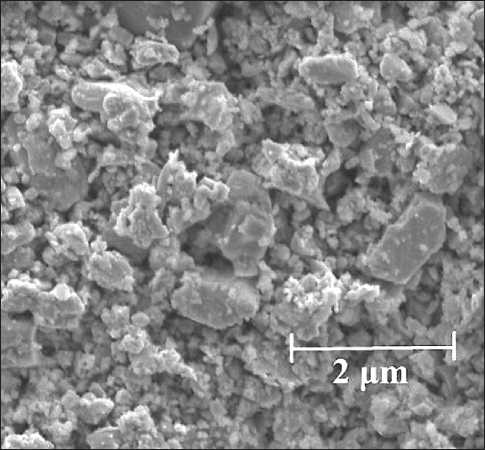
Рис. 1. Микрофотография порошка смеси карбидов вольфрама и титана твердели в формах в воде и после распалубки до момента испытаний (на 28 сутки твердения) – в ванне с гидравлическим затвором при температуре окружающей среды 20 ± 2оC и относительной влажности воздуха не менее 90%.
При изготовлении цементно-песчаных смесей за постоянные факторы приняты цементно-песчаное отношение Ц/П = 1:3, водоцементное отношение В/Ц = 0,4. На каждый вид исследования готовили по шесть образцов и заливали в формы-балочек (4×4×16 см). Все образцы подвергались компактному вибрированию на встряхивающем столе для лучшего уплотнения, и были извлечены из форм после 24 часов отверждения при 100% относительной влажности, и хранились в ванне с гидравлическим затвором при температуре окружающей среды 20 ± 2оC и относительной влажности воздуха не менее 90% до испытания на сжатие и изгиб на 3, 7, 14 и 28 сутки твердения.
Исследования растекаемости цементного теста производили с использованием мини-конуса. Цементное тесто готовили согласно таблице 2. Общее
Таблица 2
Пропорции цементной смеси
|
Содержание компонентов в цементной смеси, г |
||||||
|
Обозначение |
М0 |
М1 |
М2 |
М3 |
М4 |
М5 |
|
Цемент, г |
400 |
396 |
392 |
388 |
384 |
380 |
|
Добавка порошка WC, TiC, г |
– |
4 |
8 |
12 |
16 |
20 |
|
Содержание WC, TiC в смеси, % |
0 |
1 |
2 |
3 |
4 |
5 |
ПРИМЕНЕНИЕ НАНОТЕХНОЛОГИЙ И НАНОМАТЕРИАЛОВ В СТРОИТЕЛЬСТВЕ соотношение воды и связующего (где «связующее» определяется как портландцемент + добавка) составило В/Ц = 0,45. Мини-конус (верхний диаметр 19 мм, нижний диаметр 38 мм и высота 57 мм) помещают на стеклянную площадку, заполняют его цементной пастой, убирают излишки пасты с конуса и площадки. Конус плавно поднимали в вертикальном направлении, чтобы свести к минимуму инерционные эффекты. Растекаемость определяли измерением диаметра расплыва во взаимно перпендикулярных направлениях и вычисляли среднее. Каждая паста была исследована в трех экземплярах с использованием трех отдельно смешанных партий пасты.
Добиться равномерного распределения по объему материала высокодисперсных частиц, особенно в порошковом виде, достаточно сложно, поэтому важной операцией технологического процесса является способ введения добавки в цемент [53]. Исследовано три способа ввода добавки в цементную смесь: 1 – смешивание порошка с водой затворения, производилось с помощью верхнеприводной мешалки в течение 5 минут, далее полученная суспензия вводилась в сырьевую смесь; 2 – смешивание в сухом состоянии цемента с добавкой порошка, производилось в смесителе С 2.0 «Турбула» (г. Санкт-Петербург, ООО «Вибротехник») в течение 5 минут, далее вводилась вода затворения; 3 – исследуемый порошок был подвержен двухстадийному ультразвуковому диспергированию в водной среде в течение 30 секунд при частоте 22 кГц с целью разбивания крупных агломератов и 30 сек при частоте 44 кГц для более эффективной деагломерации частиц при помощи ультразвукового диспергатора УЗД-22/44 (Украина). Критерием оценки эффективности способа ведения добавки в цемент принята прочность цементного камня на сжатие на 28 сутки твердения по 6 штук на каждый вид исследования.
Исследование водопоглощения производилось на образцах кубической формы 20×20×20 мм. Все эти образцы были высушены при 80оC в течение 24 часов, чтобы свести к минимуму повреждение микроструктуры от чрезмерной сушки, затем помещены в емкости с водой, в которых поддерживалась постоянная температура (20 ± 2оС). Образцы подвергались взвешиванию через каждые 24 ч насыщения водой с точностью до 0,01 г. Насыщение образцов производилось до тех пор, пока результаты взвешиваний стали отличаться не более чем на 0,01 г от предыдущих взвешиваний. По степени водопоглощения по массе и объему и значениям истинной и средней плотности цементного камня рассчитывалась общая пористость.
Для исследования прочностных свойств, подготовленные цементно-песчаные образцы выдержи- вали в течение 3, 7, 14, 28 суток, а затем испытывали на прочность при сжатии и изгибе. На каждый образец было испытано не менее шести образцов для каждого типа и возраста образца, результаты усреднены. Исследования физико-механических характеристик проводилось с использованием универсальной испытательной машины ТРМ – 500 «Tochline» (ООО «Завод испытательных приборов» (ЗИП), г. Иваново, Россия, наибольшая предельная нагрузка 50 кН).
Для определения особенности гидратации и влияния добавок WC, TiC на свойства цемента с точки зрения динамики тепловыделения использовали автоматизационный дифференциальный электрокалориметр ToniCAL Trio при температуре 20оС (Toni Technik Baustoffprüfsysteme GmbH, Germany). Продолжительность измерения – 72 часа, соотношение вода/связующее составляло 0,5. Вес образца – 10 г.
Кристаллическую структуру материалов исследовали с помощью рентгеновской дифракции (ARL X’TRA, Thermo Techno) с источником CuKα в диапазоне углов 2θ от 4о до 56о в режиме асимметричной компланарной съемки со скользящим углом падения α = 3о (θ-scan). Идентификация фаз и индексирование пиков осуществлялись по базе ICDD (International Centre for Diffraction Data) JCPDF.
Микроструктуру скола исследуемых цементных образцов на 3, 7 и 28 сутки твердения исследовали на сканирующем электронном микроскопе PHENOM pro X фирмы: Phenom–WorldB.V. (Нидерланды) с интегрированной системой энергодисперсионного анализа. Максимальное увеличение – 150 000, разрешение – 10 нм, ускоряющее напряжение – 5, 10, 15 кВ.
РЕЗУЛЬТАТЫ И ОБСУЖДЕНИЕ
Растекаемость цементного теста.
Результаты изменения диаметра растекаемости для цементных смесей контрольного состава (M0) и при добавлении 1–5 мас. % порошка WС,TiC (M1-M5) приведены на рис. 2.
Результаты свидетельствуют, что по мере увеличения процентного содержания добавки WC, TiC (1–5 мас.%) в цементном растворе диаметр растекания увеличивается по сравнению с контрольной смесью на 0,4–3% соответственно. Порошок карбида вольфрама и карбида титана не вступает в химическое взаимодействие с компонентами цемента. Как показали работы [32, 54], введение высокодисперсных инертных частиц (агломератов частиц), выполняющих функцию наполнителя, повышают смазывающую способность цементного теста . Занимая пустое пространство между более
ПРИМЕНЕНИЕ НАНОТЕХНОЛОГИЙ И НАНОМАТЕРИАЛОВ В СТРОИТЕЛЬСТВЕ
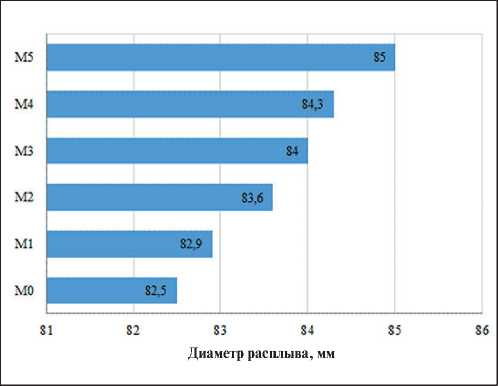
Рис. 2. Результаты исследования растекаемости цементного теста
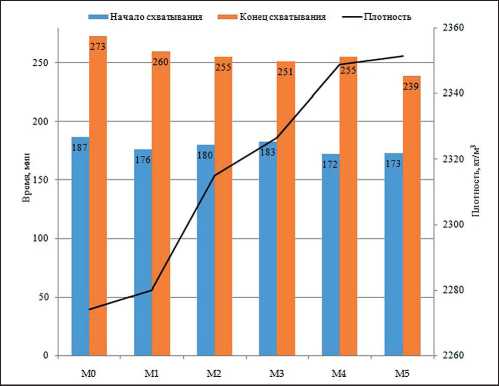
Рис. 3. Результаты времени схватывания цементного теста
крупными частицами, они высвобождают свободную воду, тем самым увеличивая количество воды, доступной в системе, для повышения текучести. То есть добавка выполняет роль смазки, увеличивая текучесть раствора.
Сроки схватывания и плотность
Сроки схватывания определялись с использованием прибора Вика. Результаты исследования влияния высокодисперсных порошков смеси WC, TiC на сроки схватывания портландцемента представлены на рис. 3.
Из рис. 3 видно , что с увеличением содержания в составе добавки порошка WC, TiC увеличивается плотность цементных образцов, это можно объяснить высокой удельной плотностью исследуемой добавки по сравнению с удельной плотностью портландцемента. При небольшом содержании добавки WC, TiC (до 1%) наблюдается незначительное увеличение плотности (на 0,3%), в случае содержания добавки (4–5%), плотность увеличивается более чем на 3%.
Сроки схватывания у цементных образцов, модифицированных порошком, при концентрации модификатора 1÷5 мас.% сокращаются: начало схватывания уменьшается на 7,5%, конец схватывания – на 12,5%, что может быть связано как с уменьшением доли цемента из-за включения добавок WC, TiC, так и с увеличением степени гидратации портландцемента, а также с наличием большого количества частиц WС, TiC в жидкой фазе, выполняющих роль затравок для образования новообразований, что в свою очередь также способствует ускорению процессу кристаллизации и ускорению схватывания.
Влияние способа введения добавки в цементную смесь
Влияние способов последовательности введения добавки на свойства цементного камня представлено на рис. 4
Как видно из результатов исследования (рис. 4), влияние способа введения порошка в цементную смесь на изменение прочностных свойств образцов по способу 1 незначительно, максимальное увеличение прочности на сжатие – 13% (при содержании 3 мас.% WC, TiC), что связано с агломерацией частиц порошка в воде.
При сухом механическом перемешивании повышение прочности цементного камня достигает 22% (при добавлении 1 мас.% WC, TiC), при использовании предварительной ультразвуковой обработки суспензии увеличение прочности образца составляет 41% (при добавлении 2 мас.% WC,TiC) по сравнению с контрольным образцом. Данный факт объясняется деагломерированием и диспергированием высокодисперсных частиц в жидкости в результате ультразвукового воздействия и, как результат, равномерным распределением частиц в объеме цементного материала.
При увеличении содержания высокодисперсного порошка более 2 мас.% прочность цементного камня снижается. Это может быть связано с тем, что, во-первых, карбид вольфрама и титана не обладают цементирующими свойствами, поэтому чрезмерная замена цемента, должно быть, привела к снижению прочности на сжатие, во-вторых, в результате значи тельной агломерации частиц порошка при дозировке более 2 масс.% . Полученные результаты согласуются с данными других исследователей [26, 55], в работах которых отмечено, что чрезмерно высокая до-
ПРИМЕНЕНИЕ НАНОТЕХНОЛОГИЙ И НАНОМАТЕРИАЛОВ В СТРОИТЕЛЬСТВЕ
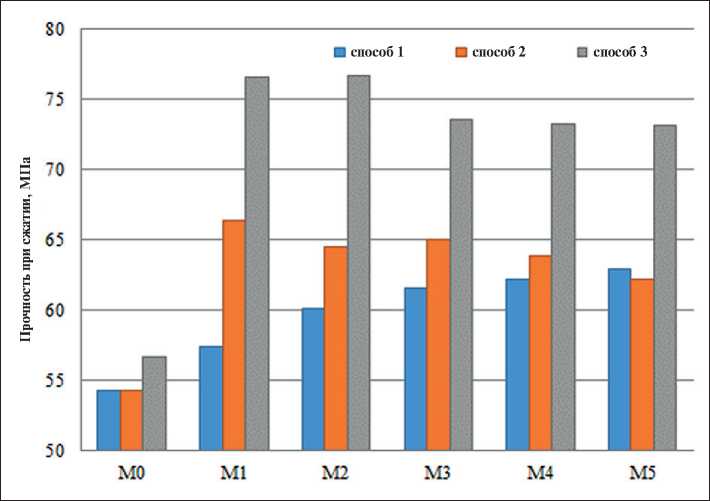
Рис. 4. Результаты исследования влияния способа введения добавки в цементную смесь на прочность цементного камня: способ 1 – перемешивание добавки в воде; способ 2 – сухое перемешивание добавки и цемента; способ 3 – ультразвуковое диспергирование добавки в водной среде).
зировка, может привести к «отравлению» системы, значительному замедлению процессов гидратации и твердения.
Анализ результатов по оценке влияния способов введения добавок в цементное тесто, а также количество содержания добавок на свойства вяжущего позволил определить рациональное соотношение высокодисперсных добавок в цементной матрице, равное 1–2 мас.% от массы цемента (прирост прочности составляет 23–41%).
Водопоглощение, общая пористость
В табл. 3 показаны значения водопоглощения и полной пористости цементного камня. Добавление 1–2 мас.% высокодисперсных частиц снизило показатель водопоглощения на 15–19%, полную пористость на 31–36%. Уменьшение пористости со-
Таблица 3
Водопоглощение и пористость цементного камня
Кинетика набора прочности на сжатие и изгиб цементно-песчаных образцов
Важнейшими показателями эксплуатационных свойств цементных материалов являются кинетические характеристики изменения их во времени. На рис. 5 представлены графики, характеризующие кинетику прочности при сжатии и изгибе цементнопесчаных образцов с добавлением 1 мас.%, 2 мас.% высокодисперсных добавок WC, TiC и без них.
Результаты показывают, что ввод в цементно-песчаный порошок смеси WC, TiC приводит не только к увеличению конечной прочности при сжатии (на 28 сутки твердения), но и к увеличению ранней скорости набора прочности образцами начиная с возраста образцов 3 суток. Из диаграммы видно, что у контрольного образца наблюдается интенсивный рост прочности в начальный период твердения, затем постепенно происходит снижение скорости набора прочности. Другой характер роста прочности у портландцемента, модифицированного добавками смеси WC, TiC, практически на протяжении 28 суток происходит увеличение набора прочности.
В частности, прочность цементного теста на сжатие на 28 сутки твердения при добавлении 1–2 мас.% WC, TiC была улучшена на 59–63%, прочность на изгиб была увеличена на 30–35% соответственно. Как видно из результатов, наиболее оптимальной концентрацией добавки является 1 мас.%, дальнейшие
ПРИМЕНЕНИЕ НАНОТЕХНОЛОГИЙ И НАНОМАТЕРИАЛОВ В СТРОИТЕЛЬСТВЕ
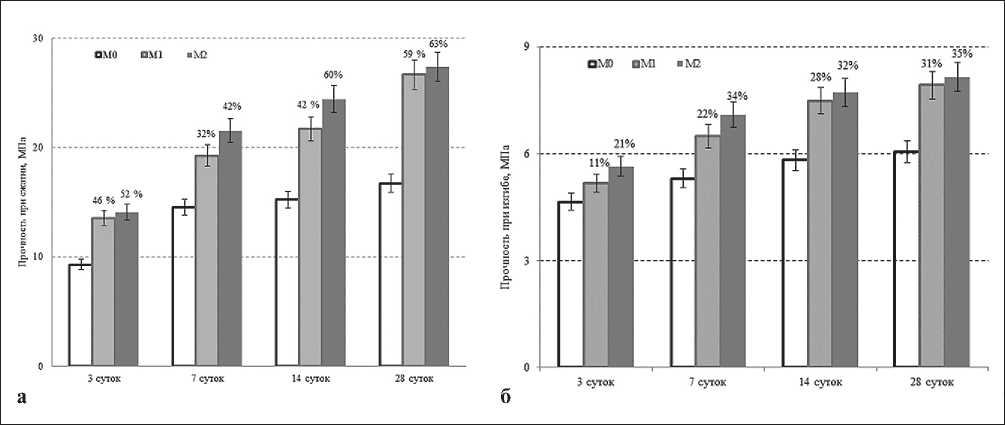
Рис. 5. Кинетика набора прочности при сжатии (а) и изгибе (б) цементно-песчаного раствора состава М0 и М1, M2
исследования проводились с этим содержанием добавки.
Для объяснения полученных выше результатов и установления закономерностей формирования состава, структуры и свойств цементного камня были проведены термокинетические исследования, рентгенофазный и электронно-микроскопический анализ контрольных и модифицированных образцов цементного камня.
Термокинетические исследования процессов ранней стадии гидратации вяжущих
С целью подтверждения полученных выше результатов были проведены термокинетические исследования (табл. 4, рис. 6), направленные на выявление особенностей гидратации вяжущего с добавлением 1 мас.% добавок порошка WC, TiC, определяемые по динамике показателей тепловыделения, выраженной зависимостью dQ/dt = f(t) в начальный период твердения, и общего количества выделившегося тепла, описываемого функцией Q = f(t) в течение 72 часов, с использованием дифференциального калориметра.
Первый пик, приходящийся на период 4-7 минут (рис. 4), связан с процессом экзотермического смачивания, а также реакциями ранней стадии гидратации. Через 5 мин 30 сек после затворения изучаемые системы показывают интенсивный рост тепловыделения (табл. 4). Его возникновение связано с растворением минералов, формирующих поверхность клинкерных частиц. В дальнейшем скорость взаимодействия цемента с водой снижается по мере насыщения раствора первичными продуктами гидратации, система входит в индукционный период (существенного влияния порошка WC, TiC на данный период не наблюдалось), после которого наблюдается повторное повышение уровня тепло-
Таблица 4
Характеристика термокинетических показателей
|
№ пробы |
Образец |
Начало реакции, сек |
Экзоэффект |
Тепловыделение макс. за 72 ч, Дж/г |
||
|
Момент достижения, ч:мин:сек |
Величина максимума Дж/г • ч |
Тепловыделение, Дж/г |
||||
|
1 |
Портландцемент |
15 |
0:05:31 |
16,53 |
1,08 |
209,9 |
|
13:03:10 |
8,11 |
70,11 |
||||
|
2 |
Портландцемент + 1% WC,TiC |
15 |
0:06:01 |
15,82 |
1,15 |
202,2 |
|
12:51:31 |
7,76 |
67,38 |
||||
ПРИМЕНЕНИЕ НАНОТЕХНОЛОГИЙ И НАНОМАТЕРИАЛОВ В СТРОИТЕЛЬСТВЕ
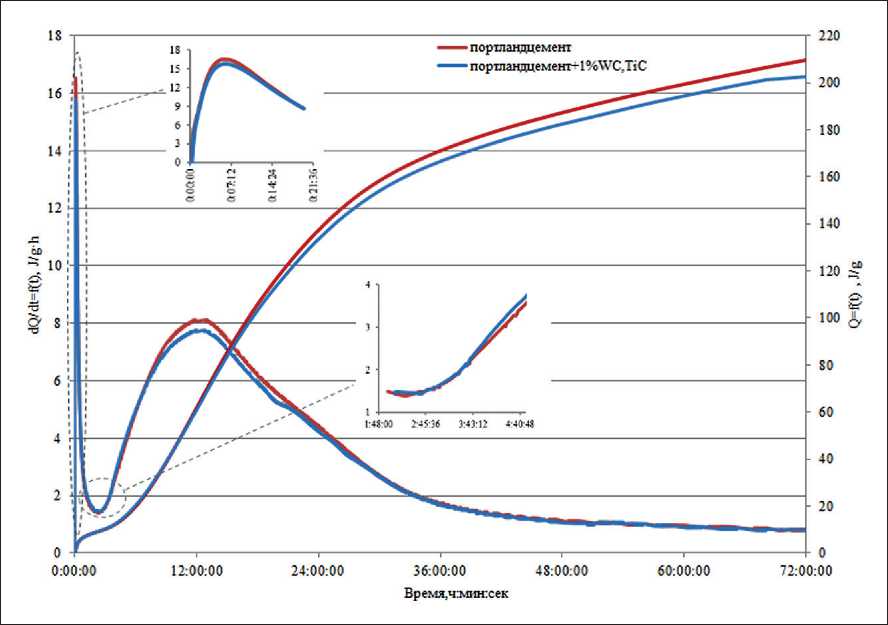
Рис. 6. Дифференциальные и интегральные кривые тепловыделения при гидратации исследуемых образцов
выделения исследуемой системы – период активной гидратации. Как показали результаты исследования, использование добавки WC, TiC ускоряет начало данного периода (табл. 4). Это может быть связано с ускоренным гетерогенным зародышеобразованием гидратов на частицах выскокодисперсных порошков. Однако, несмотря на ускорение появления основного пика гидратации, наблюдается уменьшение интенсивности тепловыделения составов с добавками по отношению к контрольному, что обусловлено уменьшением содержания портландцемента в смеси и изменением количества жидкой фазы по отношению к цементу.
Рентгенофазный анализ цементного камня
Сравнительный рентгенофазовый анализ продуктов гидратации контрольного цемента и цемента с добавлением 1% добавки WC, TiC представлен на рис. 7.
По данным рентгенофазового анализа при введении в цементную смесь 1 мас.% добавки WC,TiC на дифрактограмме наблюдается тенденция к уменьшению интенсивности пиков портландита Са(ОН)2 и пиков клинкерных минералов (C3S и C2S), а также повышение интенсивности пиков, принадлежащих гидросиликатам кальция, по сравнению с контрольным составом, приводящее к увеличению физикомеханических характеристик прочности цементного камня, что дополнительно подтверждают результаты проведенного микроструктурного и термокинетического анализа, а также механических испытаний разработанных композиций.
Микроструктура образцов
С целью изучения микроструктуры и для объяснения причин повышения прочностных характеристик цементного материала при добавлении высокодисперсного порошка было проведено электронно-микроскопическое исследование микроструктуры поверхности скола цементных образцов при увеличении x 10 000 раз на 3, 14, 28 сутки твердения (рис. 8).
Как видно из представленных микрофотографий (рис. 8а), у контрольного образца, несмотря на достижение гидратации цементной пасты 28 сутки твердения, наблюдается неоднородность структуры, большой объем открытых пор и пустот. Структура цементного образца с добавлением порошка (рис. 8б) более плотная во все рассматриваемые сроки твердения по сравнению с контрольным образцом.
ПРИМЕНЕНИЕ НАНОТЕХНОЛОГИЙ И НАНОМАТЕРИАЛОВ В СТРОИТЕЛЬСТВЕ
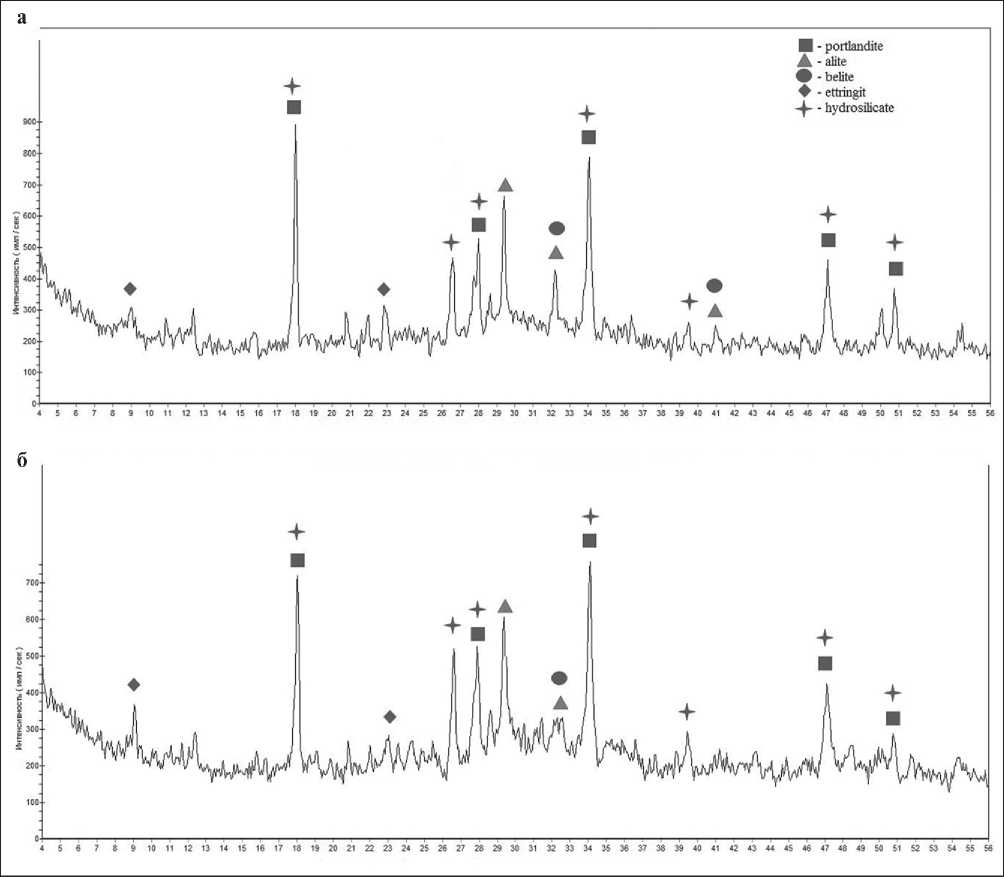
Рис. 7. Рентгенограмма цементного камня контрольного состава (а) и модифицированного 1 мас. % порошком
WC, TiC (б) в возрасте 28 суток
ЗАКЛЮЧЕНИЕ
В статье основное внимание уделялось влиянию содержания высокодисперсного порошка WC, TiC на свойства цементных паст и цементного камня: изменение сроков схватывания, растекаемости, прочности при сжатии и изгиб, а также проанализировано влияние добавления WC, TiC на термокинетические показатели, продукты гидратации и микроструктуру цементных затвердевающих паст. Из приведенного выше процесса исследования можно сделать следующие выводы:
– С увеличением процентного содержания добавки 1–5 мас.% WC, TiC в цементном растворе диаметр растекания увеличивается по сравнению с контрольной смесью на 0,4–3%, плотность цементных образцов увеличивается на 0,3–3% соответственно. Начальное и конечное время схватывания модифицированных образцов сократилось по мере увеличения содержания добавки на 7,5%, конец схватывания – на 12,5%.
– Рассмотрены способы введения высокодисперсного порошка в цементную смесь на изменение прочностных свойств образцов. При сухом механическом перемешивании повышение прочности цементного камня достигает 22%, при использовании ультразвуковой обработки водной суспензии – более 41% по сравнению с контрольным образцом.
– Добавление 1–2 мас.% высокодисперсных частиц снизило показатель водопоглощения на 15– 19%, полную пористость на 31–36% соответственно. Уменьшение пористости согласуется с улучшением
ПРИМЕНЕНИЕ НАНОТЕХНОЛОГИЙ И НАНОМАТЕРИАЛОВ В СТРОИТЕЛЬСТВЕ
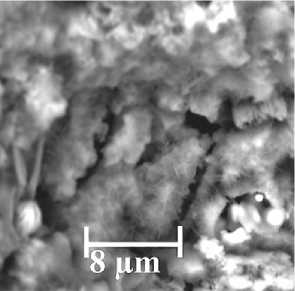
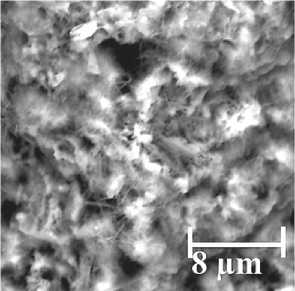
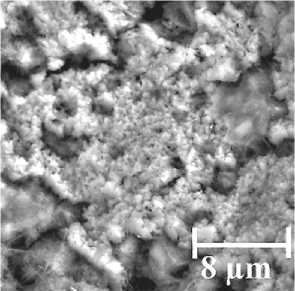
3 суток
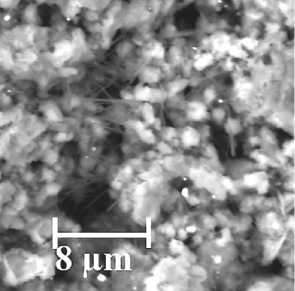
14 суток
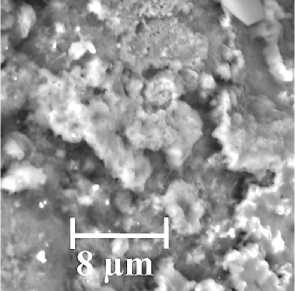
28 суток
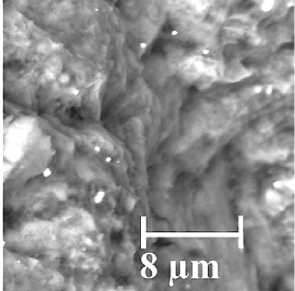
Рис. 8. Микроструктура цементных образцов контрольного состава (a) и модифицированного смесью порошков WC, TiC (б) в возрасте 3, 14, 28 суток прочности при сжатии за счет образования более плотной структуры при включении добавки WC, TiC.
– Выявлена однозначная тенденция повышения прочностных характеристик при введении в цементно-песчаную смесь порошка смеси WC, TiC как в ранние, так и в более поздние сроки твердения (на 28 сутки твердения). В частности, прочность цементного теста на сжатие на 28 сутки твердения при добавлении 1–2 мас.% WC, TiC была улучшена на 59–63%, прочность на изгиб была увеличена на 30–35% соответственно.
– Добавление высокодисперсной добавки способствовало более ранней гидратации. Это может быть связано с ускоренным гетерогенным зародышеобразованием гидратов на частицах порошков. Наблюдается уменьшение интенсивности тепловыделения составов с добавками по отношению к контрольному, что обусловлено уменьшением содержания портландцемента в смеси и изменением количества жидкой фазы по отношению к цементу.
– Рентгенофазовый анализ продуктов гидратации контрольного цемента и цемента с добавлением 1% добавки WC, TiC показал уменьшение интенсив- ности пиков портландита и клинкерных минералов, а также повышение интенсивности пиков, принадлежащих гидросиликатам кальция, по сравнению с контрольным составом, приводящее к увеличению физико-механических характеристик прочности цементного камня.
– Согласно данным сканирующего электронного микроскопа (SEM), исследуемый порошок эффективно уменьшает пустоты и дефекты в материалах на основе цемента, делая распределение продуктов гидратации более плотным. Добавление добавок повлияло на микроструктуру матрицы, при этом состав гидратированных фаз в цементных пастах не был нарушен добавлением высокодисперсных добавок, что в свою очередь не только не мешает нормальному прохождению системы через каждую стадию гидратации, но и ускоряют гидратацию.
Смесь нанопорошков WC и TiC, полученная из твёрдосплавных отходов, может найти применение в качестве модифицирующей добавки для цементных материалов при производстве бетонов как конструкционных, так и специального назначения (гидротехнических, радиационно-стойких и др.).
ПРИМЕНЕНИЕ НАНОТЕХНОЛОГИЙ И НАНОМАТЕРИАЛОВ В СТРОИТЕЛЬСТВЕ
Список литературы Влияние высокодисперсного порошка смеси Wc и TiC на свойства композиционных материалов
- Pârvan M.G., Voicu G., Bădănoiu A.I. Study of hydration and hardening processes of self-sensing cement-based materials with carbon black content. J Therm Anal Calorim. 2020; 139: 807–815. https://doi.org/10.1007/s10973-019-08535-8
- Alnahhal W., Taha R., Al-Nasseri H. et al. Effect of Using Cement Kiln Dust as a Nano-Material on the Strength of Cement Mortars. KSCE J Civ Eng. 2018; 22: 1361–1368. https://doi.org/10.1007/s12205-017-0010-6
- Сопин М.Д., Лесовик Р.В., Митрохин А.А. Крупнопористый бетон для малоэтажного строительства на композиционных вяжущих // Вестник Белгородского государственного технологического университета им. В.Г. Шухова. 2016. 10. 45-50. https://doi.org/10.12737/22024
- Askari Dolatabad Y., Kamgar R., Gouhari Nezad I. Rheological and Mechanical Properties, Acid Resistance and Water Penetrability of Lightweight Self-Compacting Concrete Containing Nano-SiO2, Nano-TiO2 and Nano-Al2O3. Iran J Sci Technol Trans Civ Eng. 2020; 44: 603–618. https://doi.org/10.1007/s40996-019-00328-1
- Yifan Wang, Hongbo Tan, Xianyue Gu, Xingyang He, Junjie Zhang. Preparation of nano-kaolin by wet-grinding process and its application as accelerator in Portland cement. Journal of Building Engineering. 2021; 44: 103401. https://doi.org/10.1016/j.jobe.2021.103401
- Ariyagounder J., Veerasamy S. Experimental Investigation on the Strength, Durability and Corrosion Properties of Concrete by Partial Replacement of Cement with Nano-SiO2, Nano-CaCO3 and Nano-Ca(OH)2. Iran J Sci Technol Trans Civ Eng. 2022; 46: 201-222. https://doi.org/10.1007/s40996-021-00584-0
- Monteiro H., Moura B., Soares N. Advancements in nano-enabled cement and concrete: Innovative properties and environmental implications. Journal of Building Engineering. 2022; 56: 104736. https://doi.org/10.1016/j.jobe.2022.104736
- Snehal K., Das B.B., Sudhi A. et al. Pozzolanic Reactivity, Hydration and Microstructure Characteristics of Blended Cementitious Composites Comprising of Ultrafine Particles. Iran J Sci Technol Trans Civ Eng. 2022. https://doi.org/10.1007/s40996-022-00859-0
- Faez A., Sayari A., Manie S. Mechanical and Rheological Properties of Self-Compacting Concrete Containing Al2O3 Nanoparticles and Silica Fume. Iran J Sci Technol Trans Civ Eng. 2020; 44: 217–227. https://doi.org/10.1007/s40996-019-00339-y
- Mahmood R.A., Kockal N.U. Nanoparticles used as an ingredient in different types of concrete. SN Appl. Sci. 2021; 3(5): 1-17. https://doi.org/10.1007/s42452-021-04461-3
- Shirzadi Javid A.A., Ghoddousi P., Zareechian M. et al. Effects of Spraying Various Nanoparticles at Early Ages on Improving Surface Characteristics of Concrete Pavements. Int J Civ Eng. 2019; 17: 1455–1468. https://doi.org/10.1007/s40999-019-00407-4
- Bharath Melugiri-Shankaramurthy, Sargam Y. et al. Evaluation of cement paste containing recycled stainless steel powder for sustainable additive manufacturing Construction and Building Materials. 2019; 227: 116696. https://doi.org/10.1016/j.conbuildmat.2019.116696
- Bharath Melugiri-Shankaramurthy, Sargam Y. et al. Evaluation of cement paste containing recycled stainless steel powder for sustainable additive manufacturing. Construction and Building Materials. 2019; 227: 116696. https://doi.org/10.1016/j.conbuildmat.2019.116696
- Potapov V., Efimenko Yu., Fediuk R., Gorev D. Effect of hydrothermal nanosilica on the performances of cement concrete. Construction and Building Materials. 2021; 269 (10): 121307. https://doi.org/10.1016/j.conbuildmat.2020.121307
- Chernishov E.M., Artamonova O.V., Slavcheva G.S. Nanomodification of cement-based composites in the technological life cycle. Nanotechnologies in construction. 2020; 2(3): 130–139. https://doi.org/10.15828/2075-8545-2020-12-3-130-139
- Nayak C.B., Taware P.P., Jagadale U.T. et al. Effect of SiO2 and ZnO Nano-Composites on Mechanical and Chemical Properties of Modified Concrete. Iran J Sci Technol Trans Civ Eng. 2022; 46: 1237–1247. https://doi.org/10.1007/s40996-021-00694-9
- 17 Gayathiri K., Praveenkumar S. Influence of Nano Silica on Fresh and Hardened Properties of Cement-based Materials – A Review. Silicon. 2022; 14: 8327-8357. https://doi.org/10.1007/s12633-021-01598-z
- Szymanowski J, Sadowski L. The Development of Nanoalumina-Based Cement Mortars for Overlay Applications in Concrete Floors. Materials. 2019; 12 (21): 3465. https://doi.org/10.3390/ma12213465
- Yaoyu Wang, Jiye Li, Lihan Jiang, Lihua Zhao Enhanced. Mechanical and Microstructural Properties of Portland Cement Composites Modified with Submicron Metakaolin. Advances in Civil Engineering. 2020; 2020: 1-13. https://doi.org/10.1155/2020/8882385
- 20 Mohan K., Pankaj M., Trivedi M.K. Strength of Cement Mortar Using Nano Oxides: An Experimental Study. International Journal of Engineering and Advanced Technology. 2019; 8 (3): 294-299.
- Liu Changjiang, He Xin, Deng Xiaowei, Zheng Zhoulian et al. Application of nanomaterials in ultra-high performanceconcrete: A review. Nanotechnology Reviews. 2020; 9(1): 1427-1444. https://doi.org/10.1515/ntrev-2020-0107
- Pietrzak A., Adamus J., Langier B. Application of Titanium Dioxide in Cement and Concrete Technology. Key Engineering Materials. 2016; 687: 243-249. https://doi.org/10.4028/www.scientific.net/КЕМ.687.243
- Szymanowski J., Sadowski L. The influence of the addition of tetragonal crystalline titanium oxide nanoparticles on the adhesive and functional properties of layered cementitious composites. Composite Structures. 2019; 233: 111636. https://doi.org/10.1016/j.compstruct.2019.111636
- Krushel’nickaya E. Evaluation of the photocatalytic activity of concrete. Bulletin of Belgorod State Technological University named after. V. G. Shukhov. 2021; 6: 13-20. https://doi.org/10.34031/2071-7318-2021-6-4-13-20
- Dong Lu, Xianming Shi, Jing Zhong. Understanding the role of unzipped carbon nanotubes in cement pastes, Cement and Concrete Composites. 2022; 126: 104366. https://doi.org/10.1016/j.cemconcomp.2021.104366
- Muhammad Azeem, Muhammad Azhar Saleem. Role of electrostatic potential energy in carbon nanotube augmented cement paste matrix. Construction and Building Materials. 2020; 239: 117875. https://doi.org/10.1016/j.conbuildmat.2019.117875
- Chernishov E, Artamonova O.V., Slavcheva G. Nano-Modification of Building Composite Structures. Strength of Materials. 2020. https://doi.org/10.5772/intechopen.86388
- Kumar Ajay, Namboodiri Vishnu, Joshi Gaurang, Mehta Kush. Fabrication and applications of fullerene-based metal nanocomposites: A review. Journal of Materials Research. 2021; 36: 114–128. https://doi.org/10.1557/s43578-020-00094-1
- Jan A., Pu Z., Khan K.A. et al. A Review on the Effect of Silica to Alumina Ratio, Alkaline Solution to Binder Ratio, Calcium Oxide + Ferric Oxide, Molar Concentration of Sodium Hydroxide and Sodium Silicate to Sodium Hydroxide Ratio on the Compressive Strength of Geopolymer Concrete. Silicon. 2022; 14: 3147–3162. https://doi.org/10.1007/s12633-021-01130-3
- Stefanidou Maria, Tsardaka Eirini-Chrysanthi, Karozou Aspasia. Nanoparticles controlling self-healing properties in cement pastes. Materials Today: Proceedings. 2021. https://doi.org/10.1016/j.matpr.2021.07.028
- Nikbin Iman, Shad Mojtaba, Jafarzadeh Gholam, Dezhampanah Soudabeh. An experimental investigation on combined effects of nano-WO3 and nano-Bi2O3 on the radiation shielding properties of magnetite concretes. Progressin-NuclearEnergy, 2019, 117, 103103. https://doi.org/10.1016/j.pnucene.2019.103103
- Kong D., He G., Pan H., Weng Y.., Du N., Sheng J. Influences and Mechanisms of Nano-C-S-H Gel Addition on Fresh Properties of the Cement-Based Materials with Sucrose as Retarder. Materials. 2020; 13(10): 2345. https://doi.org/10.3390/ma13102345
- Long Z., Chen Y., Yin W., Wu X., Wang Y. The Effects of Graphene Oxide-Silica Nano-Hybrid Materials on the Rheological Properties, Mechanical Properties, and Microstructure of Cement-Based Materials. Materials. 2022; 15: 4207. https://doi.org/10.3390/ma15124207
- Tkach E., Semenov V., Shumilina Yu. Optimization of the composition and technological processes of dispersed cement systems with high performance properties. IOP Conference Series: Materials Science and Engineering. 2021; 1030: 012024. https://doi.org/10.1088/1757-899X/1030/1/012024
- Li H., Zuo J., Dong B. et al. Effect of Lamellar Inorganic Fillers on the Properties of Epoxy Emulsion Cement Mortar. Int J Concr Struct Mater. 2020; 14. https://doi.org/10.1186/s40069-020-0395-3
- Danna Wang, Wei Zhang, Yanfeng Ruan, Xun Yu, Baoguo Han,Enhancements and mechanisms of nanoparticles on wear resistance and chloride penetration resistance of reactive powder concrete. Construction and Building Materials. 2018; 189: 487-497. https://doi.org/10.1016/j.conbuildmat.2018.09.041
- Ariyagounder J., Veerasamy S. Experimental Investigation on the Strength, Durability and Corrosion Properties of Concrete by Partial Replacement of Cement with Nano-SiO3, Nano-CaCO2. Iran J Sci Technol Trans Civ Eng. 2022; 46: 201-222. https://doi.org/10.1007/s40996-021-00584-0
- Orakzai Muhammad. Hybrid Effect of Nano-Alumina and Nano-Titanium Dioxide on Mechanical Properties of Concrete. Case Studies in Construction Materials. 2021; 14(4): e00483. https://doi.org/10.1016/j.cscm.2020.e00483
- Singh G., Saini B. Nanomaterial in cement industry: a brief review. Innov. Infrastruct. Solut. 2022; 7: 45. https://doi.org/10.1007/s41062-021-00649-z
- Lim N.H.A.S., Mohammadhosseini H., Tahir M.M. et al. Microstructure and Strength Properties of Mortar Containing Waste Ceramic Nanoparticles. Arab J Sci Eng. 2018; 43: 5305-5313. https://doi.org/10.1007/s13369-018-3154-x
- Praveenkumar T.R., Manigandan S., Gemede H.F. et al. Effective utilization of waste textile sludge composite with Al2O3 nanoparticles as a value-added application. Appl Nanosci. 2021. https://doi.org/10.1007/s13204-021-02001-4.
- Winder Raj, Chaturvedi Vaibhav, Kumar Ankit, Patel Mahesh. Utilization of Industrial Waste in Concrete Mixes – A Review. 3rd International Conference on Innovative Technologies for Clean and Sustainable Development. 2020; 29. https://doi.org/10.1007/978-3-030-51485-3_7
- Huseien Ghasan, Faridmehr Iman, Nehdi Moncef et al. Structure, morphology and compressive strength of Alkaliactivated mortars containing waste bottle glass nanoparticles. Construction and Building Materials. 2022; 342: 128005. https://doi.org/10.1016/j.conbuildmat.2022.128005
- Akram M. Mhaya, Shahrizan Baharom, Ghasan Fahim Huseien. Improved strength performance of rubberized Concrete: Role of ground blast furnace slag and waste glass bottle nanoparticles amalgamation. Construction and Building Materials. 2022; 342: 128073. https://doi.org/10.1016/j.conbuildmat.2022.128073
- Naglaa G. Fahmy, Reham M. Hussien, L.M. Abd el-Hafez et al. Comparative study on fresh, mechanical, microstructures properties and corrosion resistance of self compacted concrete incorporating nanoparticles extracted from industrial wastes under various curing conditions. Journal of Building Engineering. 2022; 57: 104874. https://doi.org/10.1016/j.jobe.2022.104874
- Tyukavkina V.V., Shchelokova E.A., Tsyryatyeva A.V., Kasikov A.G. TiO2–SiO2 nanocomposites from technological wastes for self-cleaning cement composition. Journal of Building Engineering. 2021; 44: 102648. https://doi.org/10.1016/j.jobe.2021.102648
- Meddah M.S., Praveenkumar T.R., Vijayalakshmi M.M., Manigandan S., Arunachalam R. Mechanical and microstructural characterization of rice husk ash and Al2O3 nanoparticles modified cement concrete. Construction and Building Materials. 2020; 255: 119358. https://doi.org/10.1016/j.conbuildmat.2020.119358
- Praveenkumar T.R., Vijayalakshmi M.M., Meddah M.S. Strengths and durability performances of blended cement concrete with TiO2 nanoparticles and rice husk ash. Construction and Building Materials. 2019; 217: 343-351. https://doi.org/10.1016/j.conbuildmat.2019.05.045
- Rao M.S.C., Vijayalakshmi M.M., Praveenkumar T.R. Behaviour of green concrete (blended concrete) using agroindustrial waste as partial replacement of cement along with nanoparticles. Appl Nanosci. 2021. https://doi.org/10.1007/s13204-021-01917-1
- Galuga A., Baranov G., Gavrish V., Smirnov S., Losenkov A., Vostrognutov S. Patent ЕР 3 138 932 А1, 08.30.2017.
- Chayka T., Gavrish V., Baranov G., Oleynik A., Shagova Y. Investigation of the influence of tungsten carbide nanopowder WC and the mixture of tungsten carbides and titanium carbides (WC, TiC) on the change of concrete performance properties. Journal of Physics: Conference Series. 2021; 1866 (1): 012008. https://doi.org/10.1088/1742-6596/1866/1/012008
- Gavrish V., Chayka T., Oleynik A., Derbasova N. Influence of Tungsten Nanopowders on the Kinetics of Cement Stone Strength Gain. Key Engineering Materials. 2022; 910 KEM: 697-702. https://doi.org/10.4028/p-1682bh
- Копаница Н.О., Демьяненко О.В., Куликова А.А., Самченко С.В., Козлова И.В., Лукьянова Н.А. Влияние способов активации на структурно-технологические характеристики наномодифицированных цементных композиций. Нанотехнологии в строительстве. 2022. Т. 14, № 6. 481-492. https://doi.org/10.15828/2075-8545-2022-14-6-481-492
- Choi M., Park K., Oh T. Viscoelastic Properties of Fresh Cement Paste to Study the Flow Behavior. Int J Concr Struct Mater. 2016; 10 (3): 65–74. https://doi.org/10.1007/s40069-016-0158-3
- Chernishov E.M., Artamonova O.V., Slavcheva G.S. Nanomodification of cement-based composites in the technological life cycle. Nanotechnologies in construction. 2020; 12 (3): 130–139. https://doi.org/10.15828/2075-8545-2020-12-3-130-139

